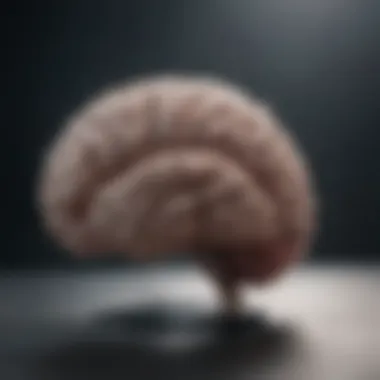Understanding Severe Treatment Resistant Depression


Background and Context
Overview of the Research Topic
Severe treatment resistant depression (TRD) represents a significant concern within mental health. This condition is characterized by persistent depressive symptoms that do not respond to conventional treatment options like antidepressants and therapy. TRD affects a substantial portion of the population, leading to severe impairment in daily functioning, and presents unique challenges to both patients and healthcare professionals.
Historical Significance
Historically, the recognition of TRD has evolved over the years. Initially, depression was often considered unresponsive to treatment as a result of individual patient factors. However, research over the last few decades has illuminated the complex interplay of biological, psychological, and sociocultural factors contributing to this condition. Improving understanding of TRD has led to the development of new treatment modalities, allowing for greater hope for patients who previously faced limited options.
Key Findings and Discussion
Major Results of the Study
Key studies have highlighted various aspects of TRD, including its prevalence rates, risk factors, and outcomes. Research indicates that approximately 30% of patients with major depressive disorder may develop TRD, underscoring a pressing need for effective interventions. Factors such as genetics, environmental influences, and comorbid health conditions can exacerbate the severity of depression and complicate treatment responses.
Detailed Analysis of Findings
An important finding is the biological underpinnings of TRD. Abnormal neurotransmitter levels, inflammation, and neuroplasticity deficits have all been implicated in the persistence of depressive symptoms despite treatment. Moreover, patients often experience a cyclical nature of the condition, wherein episodes of depression come and go, leading to increased frustration and hopelessness.
Therapeutic strategies for TRD are manifold but must be tailored to the individual. Traditional antidepressants may be re-evaluated in combination with psychotherapy and lifestyle interventions. Newer treatments such as ketamine infusion therapy and transcranial magnetic stimulation offer promise, showcasing the need for research into innovative approaches.
"Understanding the roots of treatment resistant depression allows for better, targeted therapeutic options that cater to individual needs."
Ongoing research into the genetic markers for TRD will likely play a key role in the future treatment landscape. By identifying these markers, healthcare practitioners may devise personalized treatment plans, which can enhance recovery rates and improve the quality of life for individuals dealing with this disorder.
Prologue to Severe Treatment Resistant Depression
Severe treatment resistant depression (TRD) is a crucial topic in contemporary mental health discussions. This phenomenon is marked by the failure of standard therapeutic interventions to ameliorate depressive symptoms. Understanding TRD is essential for multiple stakeholders, including healthcare providers, patients, students, and researchers in the mental health field.
Defining Treatment Resistant Depression
Treatment Resistant Depression is often defined as a form of depression that does not respond adequately to at least two different classes of antidepressants. The diagnostic challenges accompanying TRD stem from its heterogeneous nature. Many patients exhibit variations in symptoms, making standard treatment protocols less effective. It is vital to have a clear definition for both clinical practice and research, as misclassification can lead to inappropriate treatment plans.
Identifying TRD is not merely about treatment failure. It also involves evaluating the duration of depressive episodes and the presence of specific characteristics that can complicate the condition. Factors such as previous responses to treatment and the severity of current symptoms are taken into consideration during diagnosis.
Prevalence and Impact
The prevalence of treatment resistant depression is concerning. Studies show that approximately one-third of individuals diagnosed with major depressive disorder may develop TRD. This statistic highlights the widespread nature of the issue and its implications for public health.
The impact of TRD transcends individual suffering; it bears a significant burden on families, communities, and healthcare systems. Individuals grappling with TRD often experience a decline in quality of life, increased risk of comorbid conditions, and heightened vulnerability to social isolation. Furthermore, the economic costs associated with TRD, including healthcare expenses and lost productivity, are considerable.
In sum, grasping the complexities surrounding severe treatment resistant depression is vital. As this article unfolds, it will provide deeper insights into the clinical characteristics, biological mechanisms, and diverse treatment options that may be available for individuals suffering from TRD. Understanding these dimensions allows for a more informed approach to management and care.
Clinical Characteristics of TRD
The clinical characteristics of severe treatment resistant depression (TRD) provide essential insights into the nature of this complex condition. Understanding these characteristics is vital for accurate diagnosis and effective management. TRD is not only marked by a lack of response to standard treatment methods but also by a unique pattern of symptoms and variability that can differ significantly between individuals. This variability underscores the need for tailored treatment approaches that consider individual differences. The presence of associated comorbidities further complicates the clinical picture and can affect treatment outcomes.
Symptoms and Variability
Symptoms in TRD can exhibit considerable variability, making accurate assessment a challenging task. Common symptoms include persistent sadness, lack of interest or pleasure in activities, changes in appetite or weight, insomnia or hypersomnia, fatigue, feelings of worthlessness, and difficulty concentrating.
- Persistent Symptoms: Many individuals with TRD report a continuity of symptoms, which can significantly impair their functioning and quality of life.
- Variability Across Individuals: Not every person with TRD presents the same symptoms to the same extent, which can delay diagnosis and complicate treatment efforts.
- Impact of External Factors: Environmental factors, such as stressful life events or social support, can influence symptom manifestation and severity.
This variability contributes to the complexity of TRD and makes it essential for clinicians to adopt a holistic view of each patient. Assessing both the severity and the broad range of symptoms is necessary to provide effective interventions.


Associated Comorbidities
TRD often coexists with various other mental health and physical health conditions. Recognizing these comorbidities is crucial since they can exacerbate the symptoms of TRD and complicate treatment options.
- Common Mental Health Disorders: Many individuals with TRD also experience anxiety disorders, substance use disorders, or personality disorders. The interaction between these conditions can create a challenging clinical scenario that requires careful management.
- Physical Health Issues: Chronic illnesses, like diabetes, cardiovascular diseases, or hormonal imbalance, are often seen in patients with TRD. These conditions can influence treatment efficacy and patient adherence.
- Prevalence of Comorbid Conditions: Research indicates that a significant portion of those with TRD will report at least one comorbid condition, making it essential to screen for these when diagnosing TRD.
Overall, the clinical characteristics of TRD—its symptoms and associated comorbidities—play a pivotal role in shaping treatment strategies. A comprehensive understanding of these factors allows clinicians to better tailor interventions, improving the likelihood of positive patient outcomes.
"Understanding the variability and comorbidities associated with TRD is essential for comprehensive care and improved treatment outcomes."
In summary, a thorough grasp of the clinical characteristics informs practitioners and researchers alike in addressing the multifaceted nature of severe treatment resistant depression.
Diagnosing Severe Treatment Resistant Depression
Diagnosing severe treatment resistant depression (TRD) is a critical aspect of addressing this complex condition. Accurate diagnosis enables effective management, leading to better outcomes for patients who often face significant struggles with their mental health. The process involves careful evaluation of symptoms, treatment history, and an understanding of underlying factors contributing to the persistence of depression despite various interventions.
The implications of a precise diagnosis extend beyond individual patient care. It also impacts the wider mental health community, fostering informed discussions around treatment options and improving overall awareness of TRD. In this section, we will explore the framework for diagnosing TRD, setting an essential foundation for further understanding the condition.
Diagnostic Criteria Utilizing DSM-5
The Diagnostic and Statistical Manual of Mental Disorders, Fifth Edition (DSM-5) provides a standardized approach for diagnosing mental health conditions, including treatment resistant depression. For a diagnosis of major depressive disorder to be classified as treatment resistant, specific criteria must be met.
- Persistent Symptoms: Patients must exhibit symptoms of depression for an extended period, typically for a full major depressive episode duration.
- Failure of Multiple Treatments: There should be evidence of inadequate response to at least two different antidepressant therapies. This includes a combination of SSRIs, SNRIs, or other classes of antidepressants.
- Severity of Symptoms: Symptoms not only persist but also exhibit significant severity, affecting functional areas of life such as work, social interactions, and self-care.
- Exclusion of Other Disorders: The diagnosis should rule out any other primary mental health conditions that may explain the symptoms, such as bipolar disorder or substance use disorders.
These criteria serve as a foundational tool for mental health professionals. They ensure that TRD is distinguished from other forms of depression, enabling tailored and appropriate treatment strategies.
Assessing Treatment Resistance
Assessing treatment resistance in depression is a nuanced process. It involves not merely identifying that a patient has not responded to certain treatments but understanding the broader context of their treatment experience.
Key factors include:
- Treatment History: This encompasses all past treatments, including medications, dosages, and durations of trials. It is essential to document any side effects or adverse reactions that may have led to discontinuation of therapies.
- Comorbid Conditions: Often, patients with TRD have other mental health issues or physical health conditions that complicate their treatment. These comorbidities can cloud the treatment response and must be taken into account.
- Patient Factors: Each individual's lifestyle, adherence to treatment, and social support systems play a significant role in their response to therapy.
In evaluating these areas thoroughly, clinicians can better understand the complexities of treatment resistance. It allows them to devise comprehensive, personalized treatment plans aimed at improving the patient's mental well-being.
Understanding TRD is essential. It shapes treatment paradigms and drives the need for innovative strategies tailored to each individual's needs.
This section on diagnosing TRD is fundamental for translating clinical knowledge into effective practice. By grasping the criteria and assessment strategies, practitioners can contribute to improved patient outcomes in a landscape riddled with challenges.
Biological Mechanisms Underlying TRD
Understanding the biological mechanisms behind severe treatment resistant depression (TRD) is crucial for developing effective treatment strategies. This aspect of TRD encompasses various elements influencing brain function and overall mental health. A deep dive into neurotransmitter dysregulation, inflammation, and genetic factors can provide insight into the complexity of TRD, shaping future research and clinical practice.
Neurotransmitter Dysregulation
Neurotransmitters play a significant role in mood regulation. In TRD, the regular balance of neurotransmitters, such as serotonin, norepinephrine, and dopamine, is often disrupted. Low levels of serotonin lead to persistent feelings of sadness and emptiness.
- Serotonin: Its shortage is widely associated with symptoms of depression.
- Norepinephrine: Insufficiency may contribute to energy depletion and lack of motivation.
- Dopamine: Its role in reward processing means that dysregulation can result in loss of interest and pleasure in daily activities.
The interactions between these neurotransmitters can be complex. When medications like selective serotonin reuptake inhibitors (SSRIs) fail, it's often due to this intricate dysregulation. Understanding this can lead to alternative treatment options, such as combining medications or exploring new pharmacological therapies.
Role of Inflammation
Research increasingly suggests that inflammation may have a substantial impact on TRD. Elevated levels of inflammatory markers, such as cytokines, are observed in many patients. This inflammation can affect neurotransmitter function and contribute to a range of symptoms.


- Cytokines: These proteins can interfere with neurotransmitter metabolism and promote feelings of sadness and hopelessness.
- Chronic Inflammation: Persistent inflammation can lead to structural changes in the brain, exacerbating depressive symptoms.
By identifying inflammatory pathways, new treatments that target inflammation might improve outcomes for individuals suffering from TRD. Current studies are looking into anti-inflammatory medications as potential adjuncts to standard antidepressants.
Genetic Factors
Genetic predisposition plays a noteworthy role in the development of TRD. Several genes are associated with mood regulation and response to treatment. For instance, genetic variations in serotonin transporter genes can affect individual responses to SSRIs.
- Family History: A family background of mood disorders increases the likelihood of TRD.
- Genome-Wide Association Studies: These studies identify specific genetic markers linked to treatment resistance, providing critical insights into personalized medicine approaches.
At the same time, understanding these genetic factors is essential for developing individualized treatment plans. Addressing TRD may soon involve tailored therapies based on the genetic profiles of patients, enhancing the chances of successful interventions.
The exploration of biological mechanisms underlying TRD is paving the way for more effective treatment strategies.
In summary, examining neurotransmitter dysregulation, inflammation, and genetic factors is essential for comprehending severe treatment resistant depression. Each of these components sheds light on why some patients do not respond to traditional therapies. By focusing on these biological mechanisms, researchers and clinicians can aim for better-targeted and more efficacious treatment methodologies.
Challenges in Treating TRD
The topic of challenges in treating severe treatment resistant depression (TRD) is pivotal for understanding the broader implications of this mental health issue. TRD does not only affect the individual but also impinges on healthcare resources. Clinicians and researchers are continuously attempting to develop effective interventions. However, several barriers complicate treatment options, leading to a cycle of frustration for both patients and providers.
Limitations of Standard Treatments
Standard treatments for depression typically include antidepressant medications and psychotherapy. These treatments, while effective for many, show limited success with TRD patients.
- Antidepressant Medications: Often, traditional antidepressants, such as selective serotonin reuptake inhibitors, fail to provide relief. Studies indicate that up to 50% of patients diagnosed with depression may not respond adequately to these medications.
- Psychotherapy: Cognitive Behavioral Therapy and other talking therapies can be beneficial. But, they require patient participation and consistency, which may be hard to maintain for someone suffering from severe symptoms of TRD.
Moreover, there are concerns about potential side effects. Many patients abandon treatment due to adverse reactions or a lack of noticeable improvement. This creates a gap in care where individuals feel hopeless about their options.
Patient Adherence Issues
Adherence to treatment plans is crucial for success in managing TRD. Yet, many patients struggle to follow prescribed treatments.
- Complexity of Treatment Regimens: Some patients might encounter complicated medication schedules. This complexity can lead to missed doses. When patients do not take medications consistently, the likelihood of experiencing relief decreases.
- Stigma Associated with Depression: Patients with TRD often face societal stigma. This can hinder their willingness to discuss their condition or consult healthcare providers for help. Shaming or labeling can sometimes act as a barrier to seeking additional treatment.
- Lack of Immediate Gratification: Depression treatments typically do not provide instant results. Individuals may feel disheartened after not seeing quick improvements. This frustration can lead to disillusionment with the treatment altogether.
"Adherence is a decisive factor. A lack of commitment can prevent even the best therapies from being effective."
Addressing the challenges of adherence requires a multifaceted approach. Efforts may include patient education, simplified treatment plans, and increased support from healthcare professionals. Understanding these elements can improve the outcomes for patients suffering from TRD.
Exploring Treatment Options for TRD
Exploring treatment options for severe treatment resistant depression (TRD) is crucial for improving patient outcomes. The persistence of TRD despite standard interventions necessitates a thorough examination of alternative strategies that can provide relief. This section will highlight advanced pharmacological therapies, psychological interventions, and experimental strategies that are gaining traction in the psychiatric community. Assessing these options can help clinicians tailor treatments to individual needs, ultimately leading to better management of this complex condition.
Advanced Pharmacological Therapies
Ketamine Infusion Therapy
Ketamine infusion therapy has emerged as a notable approach for treating TRD. This method utilizes low doses of ketamine, a medication traditionally used as an anesthetic, to induce rapid alleviation of depressive symptoms. A key characteristic of ketamine is its ability to act quickly, often within hours, which contrasts sharply with conventional antidepressants that may take weeks to show effect.
The unique feature of ketamine infusion lies in its mechanism of action. It influences glutamate levels and promotes synaptic connectivity, providing a pathway for patients who find little success with standard treatments. While it offers significant advantages such as reduced suicidal ideation and rapid response times, there are also disadvantages. Potential side effects include dissociation, increased blood pressure, and uncertain long-term effects.
Neurostimulation Techniques
Neurostimulation techniques represent another advanced pharmacological approach to treating TRD. These methods include options like electroconvulsive therapy (ECT) and transcranial magnetic stimulation (TMS). Neurostimulation works by altering brain activity to relieve depressive symptoms.
A notable characteristic of neurostimulation techniques is their effectiveness after multiple treatments. ECT, for instance, may produce significant improvement when other treatments have failed. TMS offers a non-invasive alternative that also shows promise in clinical trials. The downside may include discomfort during procedures and a need for multiple sessions to achieve desired results, which can be burdensome for some patients.


Psychological Interventions
Cognitive Behavioral Therapy
Cognitive Behavioral Therapy (CBT) has long been advocated as an effective psychological intervention for individuals with TRD. This structured treatment focuses on identifying and changing negative thought patterns and behaviors that contribute to depression.
A key characteristic of CBT is its emphasis on equipping patients with practical skills to manage their symptoms. It encourages individuals to take an active role in their treatment. Unique to this approach is the adaptability of CBT; it can be tailored to fit each patient's specific situation, enhancing its effectiveness. However, limitations include the necessity of finding a trained therapist and the potential time commitment.
Mindfulness-Based Interventions
Mindfulness-Based Interventions, such as mindfulness-based stress reduction, focus on cultivating awareness and acceptance of one’s thoughts and feelings. This approach can provide valuable tools for individuals coping with the relentless nature of TRD.
The key characteristic of mindfulness interventions is their ability to help individuals reconnect with their present moment experiences. This can facilitate a reduction in anxiety and rumination. A unique aspect is the emphasis on non-judgmental awareness, which allows for a gentler approach to handling depression. However, these techniques require consistent practice and commitment, which may not appeal to everyone.
Experimental Strategies
Transcranial Magnetic Stimulation
Transcranial Magnetic Stimulation (TMS) is a non-invasive therapy that uses magnetic fields to stimulate nerve cells in the brain. It is often explored in cases of TRD where other treatments have been ineffective.
A significant characteristic of TMS is that it provides a promising option for patients who are hesitant about medication or invasive treatments. TMS has shown benefits in improving symptoms for a substantial number of patients. However, its availability can be limited, and treatment may involve multiple sessions, which might not fit every patient’s lifestyle or preferences.
Psilocybin Research
Psilocybin research is an exciting area in the exploration of TRD treatment options. Psilocybin, a compound found in certain mushrooms, has demonstrated the potential to provide significant relief from depression symptoms in clinical trials.
What sets psilocybin apart is its ability to induce profound psychological experiences that may lead to lasting changes in outlook and mood. The key characteristic here is its novel approach to mental health treatment, focusing on the mind's transformative capabilities. However, it remains in the experimental stage, and concerns about safety, legality, and standardization persist.
In summary, the exploration of diverse treatment options for severe treatment resistant depression is vital. Addressing TRD necessitates an individualized approach, tailoring therapies to meet each patient’s unique needs. By considering advanced pharmacological, psychological, and experimental strategies, practitioners can improve treatment prospects and arguably, the quality of life for many individuals.
Ongoing Research and Future Directions
Ongoing research into severe treatment resistant depression (TRD) plays a crucial role in advancing our understanding and management of this complex condition. The landscape of mental health continually evolves, and with it, the need for innovative solutions to address TRD's persistent challenges. Researchers are dedicated to exploring new avenues that can improve treatment outcomes for individuals affected by TRD.
One of the most significant aspects of this ongoing research is the exploration of innovative clinical trials. These trials focus on evaluating both existing and experimental treatments with the aim of identifying more effective methodologies. They also facilitate the assessment of new therapies that could offer hope to patients who have not responded to traditional interventions. New compounds, combination therapies, or alternative treatment modes are being tested to establish their efficacy and safety in larger populations. This could lead to better treatment protocols.
Additionally, integrating technology into treatment represents another significant direction within current research. Digital health solutions, such as teletherapy, mobile applications, and artificial intelligence, are being developed to enhance patient engagement and monitor treatment outcomes. These technologies can assist in tailoring interventions to meet individual patient needs, improving adherence, and potentially offering immediate support when crises arise. This focus on combining technology with traditional therapeutic approaches seeks to create a more comprehensive treatment framework for TRD.
Innovative clinical trials and technology integration are paving the way for better understanding and management of TRD.
The implications of these research efforts stretch beyond the mere introduction of new therapies. They may reshape the very framework of how mental health professionals approach treatment. Insights gained from novel clinical trials can inform clinical practice guidelines, ultimately leading to enhanced trial designs that prioritize patient-centric care. Likewise, the use of technology can lead to increased accessibility, providing patients with resources that were previously unattainable.
Ending
Understanding the complexities of severe treatment resistant depression (TRD) is critical for mental health professionals, researchers, and patients alike. This conclusion seeks to synthesize the key points discussed throughout this article, reinforcing the importance of a nuanced perspective on TRD, its implications, and the various treatment avenues explored.
Summary of Insights on TRD
Severe treatment resistant depression is defined as a form of major depressive disorder that does not respond adequately to multiple conventional treatment options. Patients suffering from TRD often experience significant impairment in their daily lives. The symptoms are not only persistent but can also change over time, further complicating diagnosis and treatment. The clinical aspects outlined in earlier sections emphasize the need for a personalized approach to treatment, considering both biological and psychological factors that contribute to the condition.
This article highlights a variety of treatment strategies. Advanced pharmacological therapies, such as ketamine infusion therapy and neurostimulation techniques, are showing promise. Moreover, psychological interventions, including cognitive behavioral therapy and mindfulness-based practices, are essential parts of a comprehensive treatment plan.
The Importance of Continued Research
The landscape of treatment for severe treatment resistant depression is ever-changing. Ongoing research is paramount to enhance treatment options and outcomes for individuals affected by TRD. Innovations such as transcranial magnetic stimulation and emerging interests in psychedelics, like psilocybin, demonstrate the exciting potential for future breakthroughs.
Continued investigation into the biological underpinnings of TRD can lead to a better understanding of the disorder's complexities. This understanding not only enriches current treatment modalities but also aids in developing new and improved therapeutic strategies.
"The need for ongoing research is not merely a suggestion; it is an imperative to improve quality of life for those suffering from TRD."
In summary, recognizing the multidimensional nature of severe treatment resistant depression is essential. As researchers and practitioners strive to advance knowledge and clinical practices, the ultimate goal remains the same: to offer meaningful relief and recovery pathways for those afflicted.







